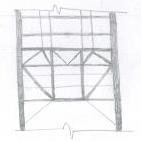
Areeb
-
Posts
18 -
Joined
-
Last visited
-
Days Won
5
Reputation Activity
-
 Areeb reacted to Ayesha in Steel Design by ASD or LRFD?
Areeb reacted to Ayesha in Steel Design by ASD or LRFD?
ASD is an older method that is still practised by a lot of mechanical engineers to size pressure vessels and tanks. However, for structural engineering, everywhere, LRFD is used. Here is a detailed answer I read once somewhere on the internet and saved it as it was very interesting.
-
 Areeb got a reaction from UmarMakhzumi in Torsion Value for beams in ETABS
Areeb got a reaction from UmarMakhzumi in Torsion Value for beams in ETABS
Dear Engr. Salman,
As you have said yours is a SMRF system, it would be better if you try to avoid reducing the torsion modifier to 0.1, however in some cases even if you increase the beam depths to 1000 mm it still fails or increase the width to say 400 mm or 500 mm. So try to increase your beam cross section but if it is still failing then reduce the modifiers. The practice of reducing the modifiers is not wrong as you are in a way transferring the torsion from beam to other structural members.
Thanks and Regards,
Areeb Ahmed.
-
 Areeb reacted to Ayesha in Releasing compatibility torsion in beams
Areeb reacted to Ayesha in Releasing compatibility torsion in beams
This topic has been extensively discussed in the forum. See the topic below.
-
 Areeb got a reaction from UmarMakhzumi in Stepped Column-Bursting Effect
Areeb got a reaction from UmarMakhzumi in Stepped Column-Bursting Effect
Well as its sudden reduction in width of the column my advice is to consider this solution. Don't consider the reduction of column and instead if possible provide a beam and floating column thereby the floating column will act as point load on beam and you could design your beam for that load. Also stop that 5.4 m width column at that level and don't consider it for upper levels.
-
 Areeb got a reaction from Zain Saeed in Check For Weak Story In ETABS
Areeb got a reaction from Zain Saeed in Check For Weak Story In ETABS
Hello Fatima,
Well the procedure you have explained is correct for finding out the shear strength of columns, thereby ultimately finding out the story strength. Still I find it cumbersome and we have direct formulas for knowing the shear strength capacity of wall or column thus rather than going by the method of flexural strength we can directly find out shear capacity of wall/column and find out story strength.
Thanks for the update regarding the method used by you. Although cumbersome something new to learn today.😃
Regards,
Areeb Ahmed
-
 Areeb got a reaction from Ayesha in Structural System with small and economical crossection
Areeb got a reaction from Ayesha in Structural System with small and economical crossection
Hello,
Well as you said as per dimensions of the plot that X direction is smaller, it becomes necessary to add shear walls in X direction as it is critical in that direction during seismic analysis. Regarding the system you have asked you can provide core wall around the lift and staircase and columns, however you have to see which zone the plot is located. if it is till zone 2B then i think this system is acceptable as you can have high response reduction factor value. Also even if you are using walls you can reduce the size of walls in terms of thickness as well as length as you go to higher stories. This reduction also should be done in a reasonable manner. There is also another system of haunch girders which could be economical and can be used in zone 3 or 4. There are many systems also like frame tube system or shear wall frame system etc. which could be economical.
Thankyou,
Regards,
Areeb Ahmed.
-
 Areeb reacted to UmarMakhzumi in Raft Modifier
Areeb reacted to UmarMakhzumi in Raft Modifier
I have worked with some engineers that like to assign high stiffness modifiers to rafts to get conservative flexural and shear design of foundation. Assigning modifiers would increase amount of rebar in your raft. I personally think that this is good practice as nothing is perfectly rigid and cracking in inevitable, which would result in loss of inertia and high flexural stresses.
The general procedure is to create two models. One with no stiffness modifiers and one with modifiers for foundation/ raft. You should use the first model to calculate piles reactions and the second to do flexural and shear design.
Thanks.
-
 Areeb got a reaction from israr_sari in Stress averaging in SAFE
Areeb got a reaction from israr_sari in Stress averaging in SAFE
Hello Israr,
As madam Ayesha said there are areas of high stress concentration in raft. Could you specify the location where you are getting 10 Kip/ft2. As specified if this pressure is at corners in small concentrations then you can ignore, however if the area is large then need to apply changes to raft design.
Thanks.
-
 Areeb reacted to UmarMakhzumi in SAP negative masssource
Areeb reacted to UmarMakhzumi in SAP negative masssource
So lets locate the negative mass source values. The image that you have attached in the post above says that:
Share that table and lets probe it. So far it looks like that you might have applied equipment loads to a slab and this error that you are getting is because of meshing. I am not sure if that is the case, this is my guess. Anyway, please share the table and we can pin point the problem area.
Also, for general information, this is what ETABS does to convert load patterns into Mass Source.
and also this:
Thanks.
-
 Areeb got a reaction from UmarMakhzumi in Structural System with small and economical crossection
Areeb got a reaction from UmarMakhzumi in Structural System with small and economical crossection
Hello,
Well as you said as per dimensions of the plot that X direction is smaller, it becomes necessary to add shear walls in X direction as it is critical in that direction during seismic analysis. Regarding the system you have asked you can provide core wall around the lift and staircase and columns, however you have to see which zone the plot is located. if it is till zone 2B then i think this system is acceptable as you can have high response reduction factor value. Also even if you are using walls you can reduce the size of walls in terms of thickness as well as length as you go to higher stories. This reduction also should be done in a reasonable manner. There is also another system of haunch girders which could be economical and can be used in zone 3 or 4. There are many systems also like frame tube system or shear wall frame system etc. which could be economical.
Thankyou,
Regards,
Areeb Ahmed.
-
 Areeb got a reaction from UmarMakhzumi in SAP negative masssource
Areeb got a reaction from UmarMakhzumi in SAP negative masssource
Hello Hafsa,
Instead of adding negative value in mass source, why don't you change the value of load. I mean enter the load as negative and don't change the sign in mass source.
Thank you,
Regards,
Areeb Ahmed.
-
 Areeb got a reaction from UmarMakhzumi in Check For Weak Story In ETABS
Areeb got a reaction from UmarMakhzumi in Check For Weak Story In ETABS
Hello Fatima,
Well the procedure you have explained is correct for finding out the shear strength of columns, thereby ultimately finding out the story strength. Still I find it cumbersome and we have direct formulas for knowing the shear strength capacity of wall or column thus rather than going by the method of flexural strength we can directly find out shear capacity of wall/column and find out story strength.
Thanks for the update regarding the method used by you. Although cumbersome something new to learn today.😃
Regards,
Areeb Ahmed
-
 Areeb got a reaction from Fatima Khalid in Check For Weak Story In ETABS
Areeb got a reaction from Fatima Khalid in Check For Weak Story In ETABS
Hello Zain
The method which you have mentioned above is for finding out whether the system has soft storey or not. You can use the method mentioned above or ETABS latest version directly gives the stiffness for each storey thereby its easy to find out whether the system has soft storey irregularity.
-
 Areeb got a reaction from Zain Saeed in Check For Weak Story In ETABS
Areeb got a reaction from Zain Saeed in Check For Weak Story In ETABS
Hello Zain
The method which you have mentioned above is for finding out whether the system has soft storey or not. You can use the method mentioned above or ETABS latest version directly gives the stiffness for each storey thereby its easy to find out whether the system has soft storey irregularity.
-
 Areeb got a reaction from Badar (BAZ) in Check For Weak Story In ETABS
Areeb got a reaction from Badar (BAZ) in Check For Weak Story In ETABS
Umar,
Yeah I have checked it and by discussing it with other engineers came to find out that ETABS 16 explicitly doesn't provide data/excel format for identifying the weak story. There is a table for finding out stiffness of each story thereby helping us identify Soft Storey, but Weak Story needs to be done manually. Software MIDAS provides a table in results clearly displaying Shear Strength of particular storey, but in Etabs it is not present. Yeah by using displacements of adjacent floors it is possible to identify Soft Storey, but that method is not needed now as ETABS clearly gives us Stifnesses of each storey thereby easily helping us to find out Soft Storey in a system.
Sorry, I have quoted ACI for irregularities its ASCE
Regards,
Areeb Ahmed
-
 Areeb got a reaction from Ayesha in Check For Weak Story In ETABS
Areeb got a reaction from Ayesha in Check For Weak Story In ETABS
Hello Zain
The method which you have mentioned above is for finding out whether the system has soft storey or not. You can use the method mentioned above or ETABS latest version directly gives the stiffness for each storey thereby its easy to find out whether the system has soft storey irregularity.
-
 Areeb reacted to UmarMakhzumi in Questions Need To Answers
Areeb reacted to UmarMakhzumi in Questions Need To Answers
Welcome to the forums.
Here are the answers:
1) To satisfy code requirement that dynamic analysis base shear can't be less than 85% of static analysis base shear.
2) Static load combinations for static loads like dead, wind, live and snow and dynamic load combos for earthquake.
3 and 4) Please see the following articles on this forum:
5 and 6) Please see the following articles on this forum:
7) Please see the following topic:
8) Because it would result in huge over-design. Its counter intuitive and defies statistical philosophy behind load combinations.
9) Inertia causes forces and mode shapes.
10) The difference is hard to summarize in a short answer. You can post a new topic and we can discuss it there. Time history is more accurate.
11) Effect is in the form of deformation. Slabs are considered rigid in plane and may deform in their plane. You need to design them such that they can transfer lateral loads to lateral load resisting system. Beams deform and bend under seismic loading.
12) Right.
13) Please see this article:
14) Don't put.
15) Energy dissipation, cracking, elasticity
16) Please see answers to 3) and 4) above.
Hope that helps.
Cheers!
-
 Areeb reacted to Yasir Saleem in Construction Of Special Moment Resisting Frame
Areeb reacted to Yasir Saleem in Construction Of Special Moment Resisting Frame
asad R is structural participation factor for the base shear.we make our structures in two different ways one that whole structure bears the base shear force and still remains in the elastic range there is no plastic hinge formation or non linear range... and other way is that we design our structure such that some part of base shear is resisted by structure and remaining part is shared by the ductility of the structure and structure goes into non linear range and hinges are formed.
what we prefer that our structure behave the second way so it some part remains in the elastic range and other part in plastic.Plastic hinges are only preferred in the higher zones like you mentioned 3 or 4.In low zones we don't make plastic hinges as it makes structure uneconomical so we do more elastic and little bit ductile structure.. So the value of R is kept low as this value is divided by the base shear and the force which comes out is taken by the structure and remaining is taken by the ductile part of structure....In normal zones structures are low ductile and value of R is less.
Now if we go to the higher zones like 3 or 4 what we want is that our structure should be flexible and it resist all the seismic forces and should not fail at any stage. So SMRF structure is preferred and Strong column weak beam structure is designed. So when we take value of R like 8 or 9 it means that base shear divided by R the value we get is resisted by structure and the remaining force is very big goes to the ductile part of the structure so just to get that much ductility or flexibility in the structure plastic hinge phenomena is introduced in the structure. What happens in the plastic hinge that our structure gets all the deformation and it goes to the plastic hinge region but it don't fail or fall down but this is only in very severe cases or very high zones. In plastic hinge we keep very close reinforcement at the beam column joint what happen with this reinforcement that concrete is more confined as we know that in concrete structures failure only occurs due to the cracking of concrete and steel fails at very very late stage so with this extra shear reinforcement we make structure flexible such that large deformations occur but no failure of structure.
So i hope that you will get it now and Plastic hinges are made in SMRF structures as they are specially designed to resist severe seismic actions. and plastic hinges are formed that our structure should not fail at any cost it should go in non linear range ... I suggest you to read some thing about the push over analysis and non linear hinges in structures ...
I hope that now you are much clear what i mean but still if you have any doubts please donot hesitate to ask...





